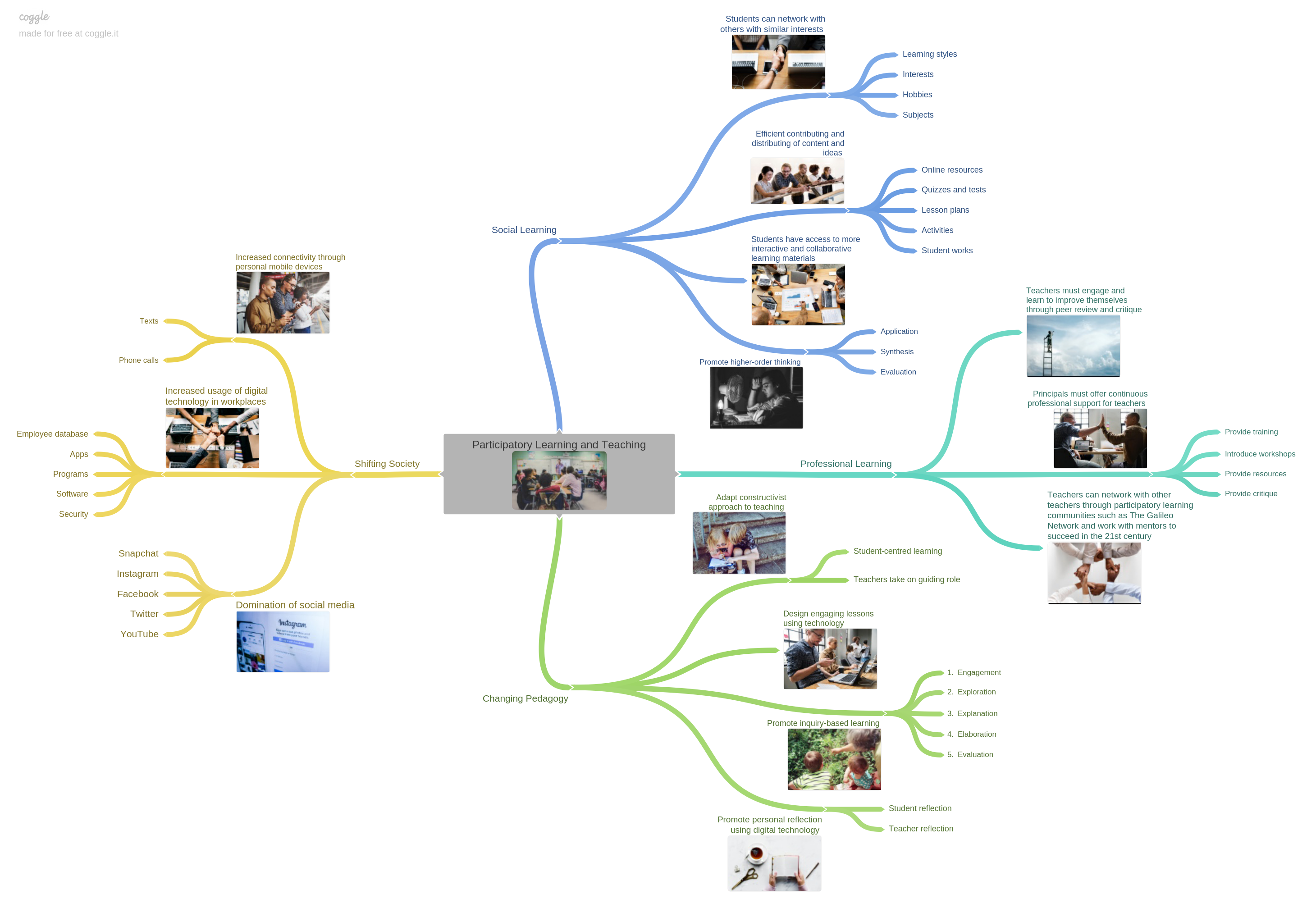This blog post is a response to the article by Michele Jacobsen and a video by Henry Jenkins regarding participatory learning in classrooms. I choose to do a mind map on Coggle for this reflection because of the ideas presented in the two pieces and the concept behind participatory learning. We are currently in a transition period in bringing the digital technology that everyone uses in their daily lives into the classrooms. As such, the article explores the different possibilities that digital technology can bring to teaching and how we as educators can better prepare for the change. This is similar to a mind map, where a central idea is presented, and various aspects of that topic are mapped out or explored as diverging branches. In my artifact, I present four major aspects that are touched upon by the article, which are a shifting society, our changing pedagogy, the benefits of social learning, and the need for professional learning. All the images are obtained from Unsplash.

In our day-to-day lives, we are exposed to various forms of digital technology including cell phones, laptops, televisions, projectors, and so on. We use these devices to perform complex tasks, check the news or weather, or keep in contact with friends and family through social media. As such, our world has become incredibly digitized (when was the last time one went without using any form of digital technology listed above?). Even in work places, employers are incorporating various technology to improve efficiency and promote their businesses locally and abroad. They are increasingly looking to hire graduates with high digital literacy skills. As a result, schools are looking to improve the digital literacy of children. In participatory learning, teachers are demanded to develop lessons incorporating technology. This means that our pedagogy must change from one of traditional, teacher-centred essentialist mindset into one of more modern, student-centred constructivist mindset. From this, students can engage in social learning, and they can use technology to interact and collaborate more efficiently with peers and teachers, contribute their ideas more freely, and network with other students with similar interests. However, this also means that teachers must be able to keep up with the demands of society. They must engage in professional learning which can be provided through support from principals and other teachers, and through participatory learning communities online.
Overall, I think that a lot of the points raised in the article are important, such as the need for professional learning and the need to prepare our students within a rapidly changing society. In this respect, my opinions are mostly unchanged before and after reading the article. After all, they will become the backbone of our country in the future as they enter the work force. The author even states that participatory learning provides measurable benefits to students through previous studies. However, what I thought was interesting about the article was the types of learning that participatory learning can induce. I have not really given this much thought before, but it opened my mind a little into the teaching and learning possibilities. For example, the strong constructivist approach means that students can apply their own learning style to build their knowledge, which traditional classrooms may struggle to meet. However, it is also important to keep in mind the dangers and drawbacks of digital technology. I often hear in the news about cyber spying and hacking, and I believe that it is critical that this be addressed in classrooms. In my opinion, it is our duty as educators to educate students on the need for cyber security and net etiquette. From the article by Tufekci, the dangers of social media and digital technology are clearly highlighted. In addition, if these technologies are abused, they can easily be used for cyber bullying or cheating on assignments and tests. Furthermore, cell phones and laptops can also act as major distractions in classrooms if proper rules and management are not put into place. This was seen from time to time during my practicum when students will be engaged during activities such as Kahoot, but would browse social media during other times and not paying attention during class. As such, it is important to keep both the positives and negatives in mind when building a successful and meaningful participatory learning environment.
Using Coggle has been quite a learning experience for me. The platform was relatively easy to use, although it took me a while to figure out how to present the ideas in an aesthetic manner (i.e. formatting the lines and text boxes). I choose to use it over bubbl.us because it allows for image uploads on free accounts (albeit, a bit small). Manipulating the nodes has been straightforward as well and saving and exporting the finished mind map is extremely convenient and accommodating. It allows the user to either share it through a URL or export it in a variety of formats such as PDF and PNG. Coggle is a platform that I may consider using in the future, whether it is for personal or educational use.
